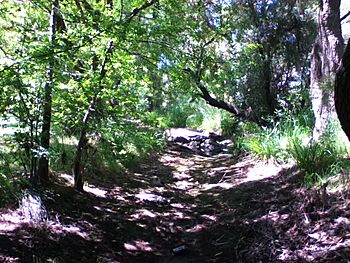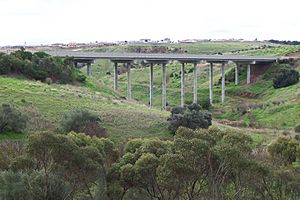Field River facts for kids
Quick facts for kids Field |
|
|---|---|

Field River in summer 2012 near Happy Valley
|
|
|
Location of the river mouth in South Australia
|
|
| Country | Australia |
| State | South Australia |
| Region | Adelaide |
| Physical characteristics | |
| Main source | Mount Lofty Ranges |
| River mouth | Gulf St Vincent south of Hallett Cove 35°05′02″S 138°29′37″E / 35.083753°S 138.493692°E |
| Basin features | |
| River system | Onkaparinga River |
| Basin size | 55.3 km2 (21.4 sq mi) |
The Field River is a small waterway in the southern part of Adelaide, South Australia. It's like a natural drain for the city, helping to carry water from the land to the sea. The river is named after Lieutenant W. G. Field, a naval officer who explored the area a long time ago.
Contents
River's Path and Features
The Field River is part of the larger Onkaparinga River system. This means it collects water from a specific area, like a big funnel. The river's catchment area is about 55.3 square kilometres (21.4 square miles).
It gathers water from places like the Happy Valley Reservoir, parts of Main South Road, and the Southern Expressway. Many suburbs are located along the river's path. These include Hallett Cove, Reynella, Shiedow Park, Trott Park, Happy Valley, and Woodcroft.
Water Flow and Changes
The amount of water in the Field River changes a lot throughout the year. It's very dependent on the seasons. During the hot summer months, most of the river can dry up completely. It might stay dry until autumn.
However, the very end of the river, near its mouth, is fed by underground springs. This means it always has water flowing into the Gulf St Vincent, even in dry periods.
Community and Environment
The Field River flows through or borders two local government areas: the City of Marion and the City of Onkaparinga. For many years, the lower part of the river was on private land. This land was later sold for housing.
Today, some parts of the river further inland are still privately owned. These areas are important for a planned project called the Great Southern Urban Forest. This project aims to plant many trees and create green spaces in Adelaide.
Local primary schools, such as Braeview, Reynella East, and Hallett Cove South, are actively involved with the Field River. They have projects to plant new trees and study the river's environment.
River's History

In the 1840s, the mouth of the Field River was used for secretly bringing goods ashore to sell in Adelaide. Later, in 1850, a government group looked at the river's mouth. They thought it could be a good place for a safe harbour where ships could stop.
Mining and Fossils
Copper was found nearby in the 1840s at the Worthing Mine. People hoped to use the Field River to transport the copper ore to the sea. But by 1856, mining stopped because there wasn't enough money to continue.
The river also runs through steep, undeveloped land that was once used for quarrying in the early 1900s.
The coastline near the Field River was very important to the Kaurna people. They are the original Aboriginal inhabitants of this region. Many cultural items have been found near where the river meets the sea.
In 1992, an amazing discovery was made on the riverbank. Trevor Westlake found the fossil remains of a Diprotodon. This was the world's largest marsupial, a type of animal with a pouch. This fossil is at least 70,000 years old. It is now kept at the South Australian Museum.
How the River Got Its Name
The Field River was named after Lieutenant W. G. Field. He was a naval officer who worked with Colonel Light. Light was an important explorer who surveyed South Australia in 1836. Lieutenant Field sailed with him on a ship called the Rapid. Colonel Light himself visited the river in 1837 while exploring the area.
For a while, the river's name was changed to Hallett Creek. This was because the Onkaparinga River was also sometimes called "Fields River," which caused confusion. But later, in the 20th century, it was renamed Field River again. In 1990, there was even talk of changing its name to Serpentine Creek, but that didn't happen.


